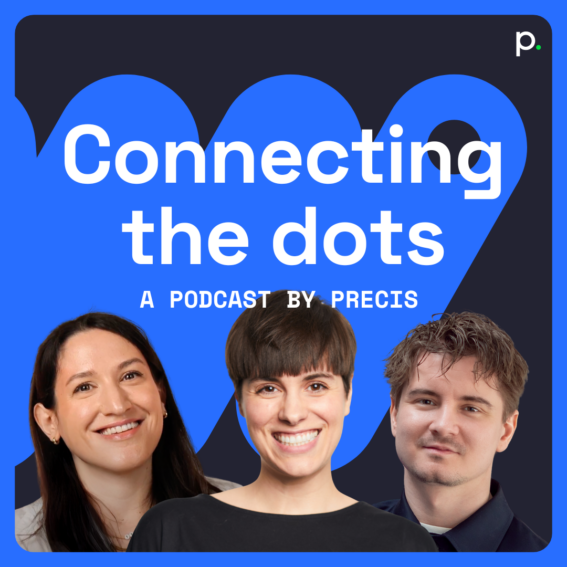B2B marketing metrics you need to be tracking now

Matilda Iwanson
B2B Senior Client Lead
I don’t see much difference between B2B marketing and gaming. That might sound like a stretch, but hear me out. Both thrive on strategic planning, a keen eye on the target and skilful team management, and the crucial need to make smart, calculated moves based on scorecards.
Those scores in B2B marketing are your metrics — they tell you what’s working. Are you grabbing attention? Are leads turning into sales? Are you hitting your targets or do you need to switch up your strategy?
Just like in a game, it involves understanding what actions you want your customers to take and efficiently guiding them towards those actions. You test out what tactics engage your audience the best, use what you learn, and keep improving.
But here’s the problem: Marketing isn’t a level playing field in B2B.
Take it from me – having spent 4.5 years in the B2B space at Precis and even more in gaming – and from our wise friends at The F Company:
“There’s a big difference between selling a €20 subscription to a freelancer vs a €200k project to a buying committee. In complex B2B, no one wakes up in the morning, Googles you and decides to buy your product or service.”
Feeling the pulse of what really makes your business tick is super important, so you can check if your investments are giving you that ‘wow’ factor you’re looking for. In other words, having the right scoreboard set up is a very important part of your game!
As a B2B marketer, it’s all too common to see businesses obsess over metrics that simply don’t align with their strategy (or overall goals, for that matter). Those are called vanity metrics, and you’ll want to stay away from them because, honestly, it is very frustrating. But before we talk about metrics, let’s talk about the players of the B2B game.
What players are we talking about here?
(Disclaimer: this is the part where I get a bit nerdy, so bear with me)
Success and business value mean different things to different B2B businesses, but based on our experience and market trends, I see them as two…. player types: the Marathon runners and the Sprinters.

The Marathon runners
These players (B2B businesses) are like the grandmasters of chess or commanders in World of Warcraft. These are typically large enterprises engaged in playing fields with lengthy sales cycles involving numerous stakeholders.
Working with/for such B2B companies means:
- Slow processes
- Budget approvals
- Thousands of touchpoints
- Long sales cycles (6+ months avg)
- F2F sales still play an important role
- Procurement and legal
- Large buying committees with influencers and budget holders
- Most of your audience is not ready to buy. Not now, and maybe not in a year
For these companies, it’s all about the big picture. They’re not just chasing quick wins or short-term gains. Instead, they’re focused on building long-term relationships and earning trust that lasts. They measure their success not just by immediate returns, but by the strong, lasting empires they build over time.
And so, marketing supports this game plan with the following:
- Content focus: Creating high-quality, informative content that positions the brand as a thought leader and educates potential clients over an extended period. This helps build trust and keeps the brand top of mind throughout the prolonged decision-making process.
- Supporting sales with education: Working closely with sales to provide educational materials that help stakeholders understand complex products or services. This not only nurtures leads but also assists sales by preparing leads with the necessary knowledge to make informed decisions.
Simply put, the marketing metric that matters the most for these players: Engagement!
This includes tracking which stakeholders are interacting with the content and how these interactions influence their journey through the sales funnel.
The Sprinters
Now imagine the fast-paced energy of a “Candy crush” 🍬. These are typically smaller or fast-growing businesses or those in sectors where agility trumps size, characterised by shorter sales cycles e.g. SaaS companies!
Working with/for such B2B businesses means:
- Quick decision making
- Smaller budgets
- Fewer touchpoints
- Short sales cycles
- Digital sales focus
- Simple procurement
- Smaller committees
- Ready-to-buy customers
These businesses value speed and adaptability, and immediate results are paramount. Digital marketing campaigns, direct CTAs, and promotions are common strategies that align with the fast-paced nature of their business and so, they are totally into:
- Quick conversion strategies: Using aggressive marketing tactics that compel immediate action. This includes digital ads with strong calls to action, time-sensitive offers, and high-impact social media content.
- Efficiency in responses: Ensuring that teams respond quickly to leads, as Sprinters value speed. This rapid response is linked directly to higher conversion rates, as potential clients in these markets often make quick decisions based on immediate needs.
To sum up, the marketing metric that matters the most for these players: Conversion!
By monitoring Conversion Rates and Time to Conversion, for example, they can tweak the effectiveness of campaigns in real-time and adjust strategies quickly to maximise ROI.
What B2B metrics (scorecards) matter then?
Now let’s really drill down on the marketing metrics that matter to these 2 player types (businesses).
Marathon runners: Businesses with long (typical) sales cycles
Think of managing metrics for Marathon runners like leading a team in a big online game.
In marketing, it’s all about creating strong relationships and staying on people’s minds for when they’re ready to buy (95% of the market isn’t really interested in you at any given point in time, by the way).
Coordinating marketing and sales efforts is crucial, similar to organising a team raid in a game, where everyone must know their role and timing perfectly. Marketing educates and the sales team nurtures the lead and together, they race to close the deal.
If this sounds like your situation, it’s time to shift your focus from conversions to educating potential customers. Here’s what you should consider:
- Engagement per account: Imagine tracking the progress in a complex role-playing game. For each account, it’s not just about logging in daily; it’s about meaningful interactions. What missions are they completing? Which quests are engaging them the most? Similarly, by understanding which content engages each account and how deeply they interact, the Marathon runners can tailor make sure they keep moving along in the sales funnel
- Lead to close time: Timekeeping in gaming can be as crucial as in any time-trial race. Measuring how long it takes for a lead to become a customer is similar. They look at different types of leads—think of different player types or game modes—and see which strategies bring them quickest to the finish line – Leads engaged through digital marketing often close faster, of course!
Keep it tight with the folks in Sales, though! Their feedback is your direct line to understanding how customers journeyed to your product/service and what influenced their decisions along the way.
Repeat after me: Ask sales for input and piece together the story of a customer’s journey, make content that connects, engages and puts you top-of-mind!
💡Bonus points: Reviewing B2B metrics annually or biannually, rather than monthly or quarterly can show the real impact of marketing efforts, so… relax a bit 😉
Sprinters: Businesses with short(ish) sales cycles
When you’re marketing for Sprinters, it’s all about snagging those leads quickly and without breaking the bank. Since their products or services are usually easy to grasp, they don’t need a whole committee to approve and they aren’t too complex, marketers need to stay sharp and focused.
Here are the key metrics you should look into:
- Lead conversion time: Time is of the essence here. This measures how quickly potential leads turn into paying customers. It’s like a time trial in a racing game, where every second counts. This metric shows how agile and effective your sales tactics are.
- Conversion rates: Think of this like your hit rate in a shooting game. It shows how many of your potential leads you’re turning into actual customers. It’s a direct reflection of how on-target and persuasive your marketing is.
- Annual Recurring Revenue (ARR): For companies like those offering software as a service (SaaS), ARR is crucial. It tracks the steady income from all active subscriptions over the year. Picture it as your ongoing score in a game, showing not just a one-time win but continued success. This helps you understand your financial health and ensures your strategies keep customers coming back.
Balancing the volume of leads and their likelihood to close is super important. High-quality leads are akin to high-value targets in a game – more challenging to acquire but significantly more rewarding. And a CRM tool can give easy visibility over this!
💡Bonus points: With the eye of a tiger, track these metrics every month and optimise your strategies as quickly as you can!
Want a more specific example? We’ve worked with Brandwatch, a classic Sprinter.
Client case for B2B metrics: Personio
I may have missed another player type: the Steady Striders.
They’re like the Goldilocks of B2B, not too slow like the Marathon Runners, not too fast like the Sprinters.
- Decision-making, budgets, and touchpoints? Just right.
- Sales cycles? Not a sprint, not a marathon, but a steady jog.
- Marketing approaches? digital savvy with good old face-to-face charm.
- Buying committees? Streamlined, and clients come in all readiness levels.
- Their marketing game? A mix of engaging content and quick conversion hits.
Case in point: Personio.
Besides being one of our favourite clients, they are a cool SaaS company out of Munich that’s making life a lot easier for small and medium businesses with their software that automates the nitty-gritty of HR management. But here’s the catch – getting set up with their SaaS product isn’t as quick as clicking a button. Because of its organisation-wide impact, the buying committee needs some face-to-face convincing but deals close within months, and not years (hence, the Steady Striders).
For their paid search campaigns, Personio’s initial focus of ROAS was at the keyword level. However, their CRM data showed certain conversion actions driving more value and, since they were not being prioritised, there were inefficiencies in the ad spend.
When we partnered up, we changed the game plan by:
- Using real-world data and taking insights from their CRM more directly to sharpen their marketing decisions
- Treating leads differently, based on time to convert, the value of the closed deal, types of content engaged with etc.
We focused on these B2B metrics after switching up:
- Lead conversion efficiency: got better at converting leads without splurging budgets.
- Cost efficiency: cut down on unnecessary spending, just like saving special abilities for critical moments in a game.
- Overall revenue impact: measured the actual contribution of each lead to the bottom line to make sure their money was well-spent.
And it’s safe to say that the results speak for themselves 😏
- They got rid of excess advertising costs
- Streamlined spending led to better profits
- The new strategy tightened the teamwork between sales and marketing
Not to toot our own horn, but our efforts with Personio even earned Precis a nod at the 2024 European Search Awards! 💪
Coolio. Here’s what you hopefully got out of this B2B metrics rant:
- Metrics are your B2B marketing scorecards. They indicate what works and what needs adjustment.
- Like gaming, you need to understand what actions you want from customers and optimise strategies for quick results.
- For Marathon runners, focus on engagement and building long-term relationships rather than quick conversions.
- For Sprinters, prioritise quick conversion strategies and efficiency in responses.
- Case study: Personio exemplifies the “Steady Striders” with a balanced approach to marketing metrics.
Thoughts, questions or feedback? Drop me a DM on LinkedIn or get in touch with your local B2B marketing hero – regardless of which player you are, we have a game plan for ya 😉
Psst! Want to revisit the basics? Read our guide to B2B marketing, our B2B customer journey guide, or the takeaways from our latest B2B creatives event.




